Shhhh. Be quiet.
That’s what Jesse Barber (Ph.D. ’07), a biology professor at Boise State University, wants people to do when they’re in nature. For the past 15 years this sensory ecologist has studied how animals perceive their worlds and has conducted groundbreaking research into noise — and light — pollution. His studies reveal ways in which humans have unwittingly harmed wildlife, but his findings also hold the promise of a quieter and darker world where animals and humans better coexist.
“When you make the world quieter, birds tend to move closer to people. People have a better experience in nature, and they report more willingness to enact stronger management actions to protect quiet and biodiversity,” says Barber, who created a “phantom road” in the Boise National Forest as a way to study the impact of recorded highway noise on migrating birds.
His findings are leading scientists and possibly the U.S. government to regard mundane things such as streetlights and car sounds as health threats to an array of species, including the bats, moths, owls, songbirds and fireflies he has studied. His work has taken him around the world, from Mozambique’s Gorongosa National Park to Montana’s Pioneer Mountains, where he used a mule train to haul solar panels through heavy snow.
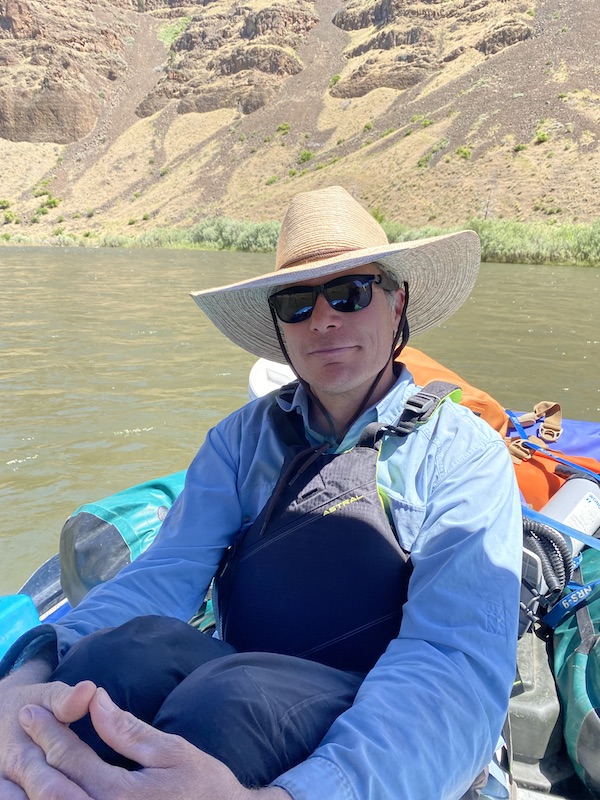
Jesse Barber (Ph.D. '07)<br /> <br /> Top, the Milky Way at Rocky Mountain National Park, Colorado. Photo by Jeremy M. White / National Park Service
“I’m continually impressed with Jesse’s ability to span different disciplines — neurobiology, physiology, evolution, ecology, acoustics,” says Clint Francis, a biology professor at California Polytechnic State University who has collaborated with Barber. “He has this exceptional knack for holding all this information in his mind and putting pieces together across sub-disciplines that’s really uncommon among researchers.”
Barber, 46, the son of a U.S. Forest Service biologist who studied grizzly bears, mostly grew up in the Chugiak community about 20 miles from downtown Anchorage, Alaska, before moving to Wyoming when he was a teen. “I remember moving there and thinking there wasn’t any real wilderness down here — you can walk across Yellowstone in a week!” he recalls.
Barber has a solution to today’s sound and light woes, one that may have been kindled in his upbringing in the Last Frontier state. It’s called rewilding, the process of reintegrating human activities with nature so that they better align with the health of the planet and all its life.
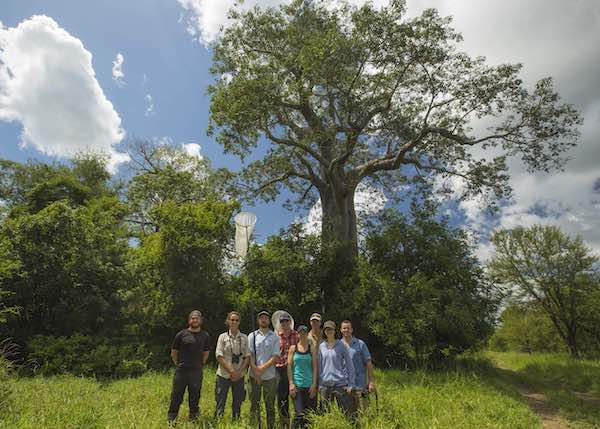
Barber researched bats and moths in Mozambique’s Gorongosa National Park.
“In a perfect world, I would build no more roads through natural habitats. I would protect the habitat we have left, and I would then try to restore and rewild as much as we can. That means removing street lights where they’re not needed and mitigating noise sources. Without changing habitat, without planting another tree, without adding another chunk of land, you can make places better right away almost immediately,” he says.
Silence as a clue
Sherlock Holmes in “The Adventure of Silver Blaze” found that the key to a mystery was silence — a dog failed to bark when it should have. Today Barber traces the origin of his research interest to a similar lightning-bolt moment about moths who no longer gathered where they should have.
As a Ph.D. candidate at Wake Forest, he studied under entomologist Bill Conner, now an emeritus biology professor. The two often drove up I-77 to Dobson, North Carolina, to do research. Their destination? A new gas station off the highway that blasted light to the heavens.
When the station opened, its lights lured both motorists and mobs of flying insects. It made a perfect spot for the two men to collect moths for Conner’s lab. “The highlight of my Ph.D. experience was talking to Dr. Conner about science every day,” Barber recalls. “Wake’s biology department was a wonderful place to grow as a scholar.”
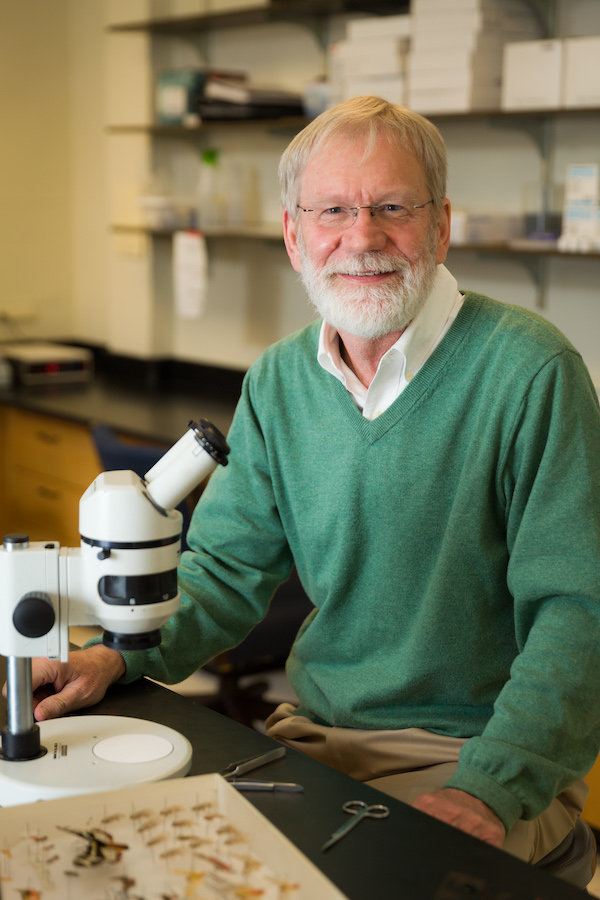
Professor Emeritus Bill Conner studies moths in his lab in Winston Hall in 2013. Photo by Ken Bennett
Together the duo studied what lepidopterist Conner dubbed “the bat-moth arms race,” a field of research Barber continued to explore in Africa after graduating.
(This 60 million-year-old co-evolutionary battle has bats firing ultrasonic blasts to echolocate moths just as submarines use sonar to “ping” elusive enemy subs. Barber discovered that moths craft anti-bat defenses in response. They shoot back ultrasonic bursts. This acoustic armor jams bat transmissions, causing bats — or “sky wolves,” as Barber terms them — to veer off an instant before seizing their prey.)
Barber and Conner, after repeated trips to the gas station, found fewer bugs. “We suspected they were being killed by birds that would arrive in the mornings when they were collected on the walls,” recalls Conner. “And that was a little spark that Jesse has continued with.”
Forty percent of insect species are in decline, according to research published in the journal Biological Conservation. The reasons are many — changing climate, human encroachment, agricultural chemicals — and light.
Barber deduced that the unnatural amount of light, something that for millions of years had not existed after sunset, was indirectly killing unnaturally large numbers of bugs.
Today many scientists believe the Earth is suffering a mass extinction of insects. Forty percent of their species are in decline, according to research published in the journal Biological Conservation. The reasons are many — changing climate, human encroachment, agricultural chemicals — and light. As others have said and Barber often notes, insects are “the small things that run the world,” and without them, all other systems will collapse.
Missing the Milky Way
Fast forward to 2019, and Barber and his grad student helpers have set up shop at a Walmart-sized parking lot in Grand Teton National Park. They have kitted out 32 streetlights with experimental LED lights. Using a tablet and a smart network, Barber can instantly change all the cobra-headed luminaires from the usual white to red light. Insects and bats cannot see its infrared frequencies, but humans can. Traps beneath the lamps snare bugs who gather there, while radio responders on bats tagged by Barber’s team tell him where they are.
The result? Far fewer bugs and bats go near the red lights. “Bats that avoided lights stop avoiding them. Bats that were attracted to lights, because insects are attracted to lights, stop being attracted,” says Barber.
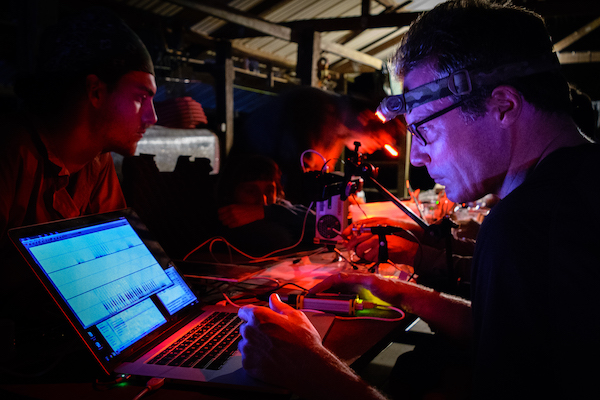
Barber collecting acoustic data on moths
But something else happens when the red lights go on. All of a sudden humans can see the Milky Way, that “broad and ample road, whose dust is gold, and Pavement stars,” as John Milton described it in “Paradise Lost.” Today 80 percent of people in North America suffer under so much light smog that they are unable to see this celestial wonder, according to research led by Fabio Falchi of the Light Pollution Science and Technology Institute in Italy.
Barber will soon publish papers that urge increased use of red lights at night and thus more human wonderment, while sparing the lives of countless bugs. He is testing different types of night sky lighting at 20 sites in the park to determine which are best for wildlife and human perception.
“If we can shift towards warmer colors, we can do some good for wildlife, and that natural baseline of darkness will still allow people to see and do tasks they need to do,” says Barber. “One of the biggest problems in our modern society is we don’t take care of the habitat that’s right next to people. The edges of cities and city parks are places where we could make them a better experience for people and wildlife.”
“Jesse has a knack for communicating good science,” says Conner, who notes “he also has a knack for working on big problems.”
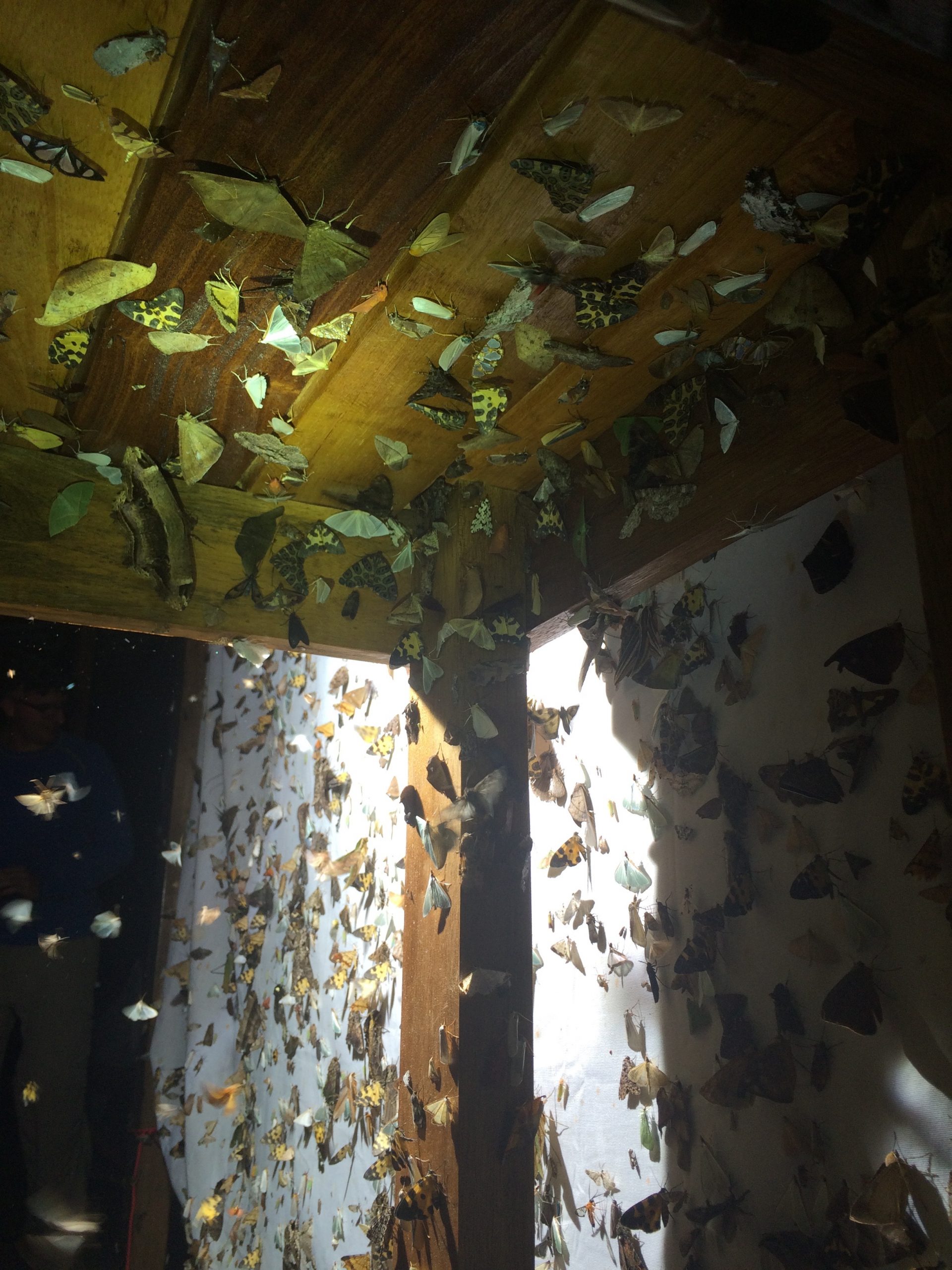
Moths collect around a UV Light
Sensory bubbles
Umwelt. This German word for environment has been adopted by scientists to refer to animals’ “sensory bubble.” It’s a favorite of Ed Yong, a reporter for The Atlantic magazine whose new best-selling book is “An Immense World: How Animal Senses Reveal the Hidden Realms Around Us.”
“Every animal has … its own umwelt, its own tiny sliver of reality that it pays attention to,” says Yong, whose earlier work, “I Contain Multitudes: The Microbes Within Us and a Grander View of Life,” won him a Pulitzer Prize. “Those worlds are fascinating because they show us our way of experiencing the world is limited, that we’re only getting a small sliver of all there is to perceive. What we think of as vision, hearing or perception is limited to us. It’s only one of many ways of experiencing the world.”
To delve into the umwelt of birds, in 2012 Barber and his fellow researchers constructed their phantom road along a ridge in Idaho, not far from Boise, where migrating birds were known to stop and feast for the long flight ahead. This virtual highway ran along a half-mile path. It consisted of 30 bullhorn speakers strapped to Douglas firs. During peak fall migration days, a minute-long sound loop roared whizzing high-speed sounds, honks and swooshes of tires on asphalt made by cars recorded in Glacier National Park.
The results were shocking. The acoustic highway drove off a third of all birds who normally would have been on the ridge. Those who stayed and were captured in nets were lighter than birds who arrived before the sounds blared. In short, they ate less while near the imaginary road. Barber concluded that noise, not the sight of cars or their smells, distracted them from their most important duty — finding food, and now they had less strength to migrate and fend off predators.
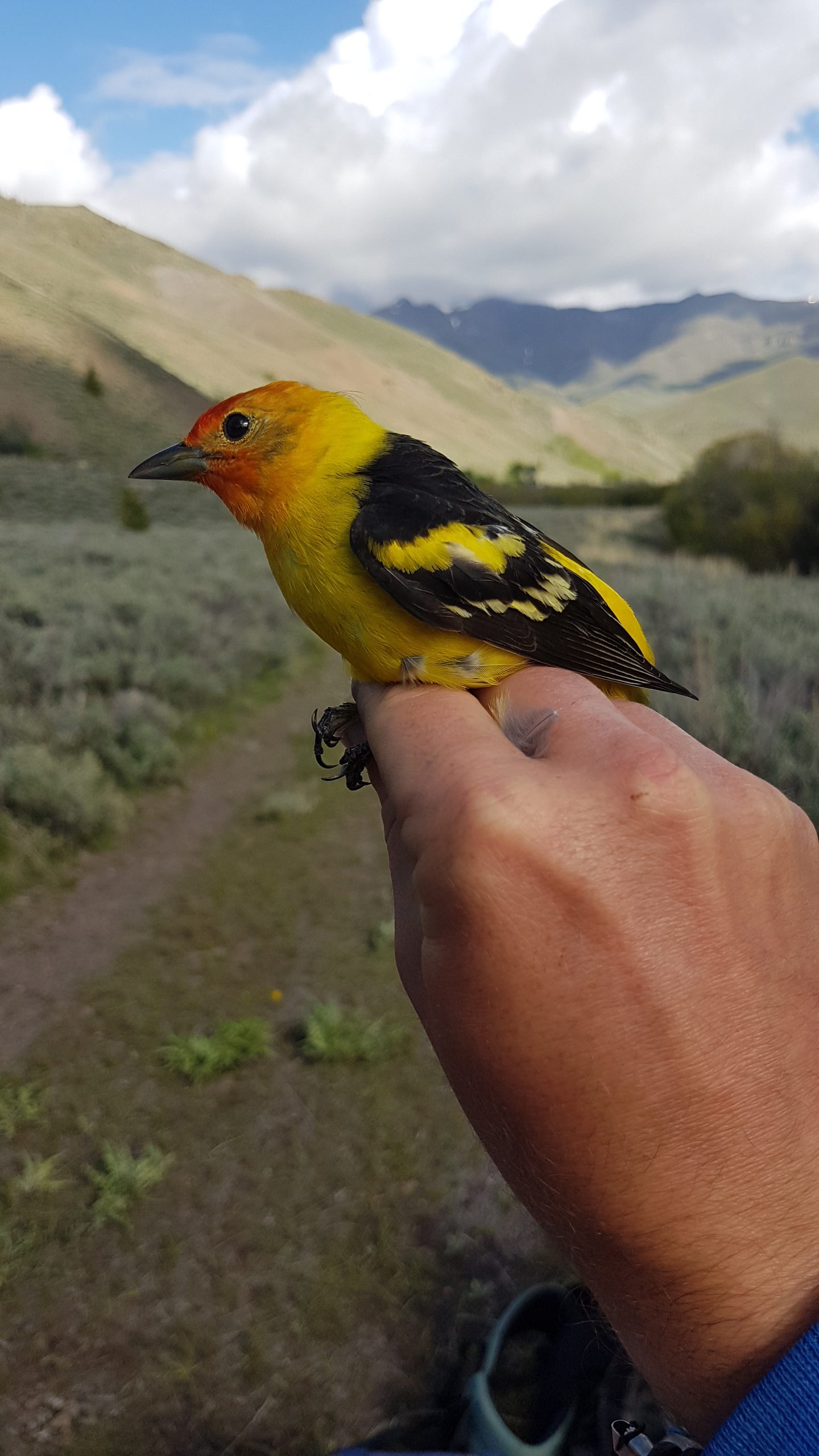
A Western Tanager in Idaho
“Noise is directly related in humans to heart disease. In animals, they can’t do their jobs. They can’t hear their mates. They can’t hear a predator or the prey they’re trying to catch. Those lost pieces of information have consequences,” Barber says.
Noise information is something Kurt Fristrup, the recently retired head of the National Park Service’s Natural Sounds and Night Skies division, collected for years. He studied human-made background sounds in parks around the United States and partnered with Barber for 15 years. “Jesse is boundlessly energetic and boundlessly productive, and he’s really well-focused,” says Fristrup.
Noise is directly related in humans to heart disease. In animals, they can’t do their jobs. They can’t hear their mates. They can’t hear a predator or the prey they’re trying to catch. Those lost pieces of information have consequences.
They co-authored a 2010 paper on chronic noise that Fristrup credits with inspiring hundreds of other papers on the ill effects of human-made sounds on wildlife. “That was a pivot point for the Park Service in terms of the science I was involved in and how it translated into meaningful shifts in our service management perspective,” he says.
“If there’s lead in the soil, you have to get the lead out. If there’s phosphorus in the stream, you have to get the phosphorus out. But with noise and light, the moment you fix things at the source, the entire environment gets better. Reducing noise and light pollution may be two of the most important tools we have to enhance ecological sustainability and robustness. By being more efficient with those things we can make the world better for people, public health and ecosystems.”
Barber cautions that research into light and noise pollution goes back only a decade and that it takes time for science to filter into policy. “There are countless issues that have not been solved or even paid attention to, even though the science is clear,” he says.
Barber says his forthcoming light pollution papers can help guide the National Park Service as it replaces buildings and streetlights with funds in the Biden administration’s new infrastructure bill.
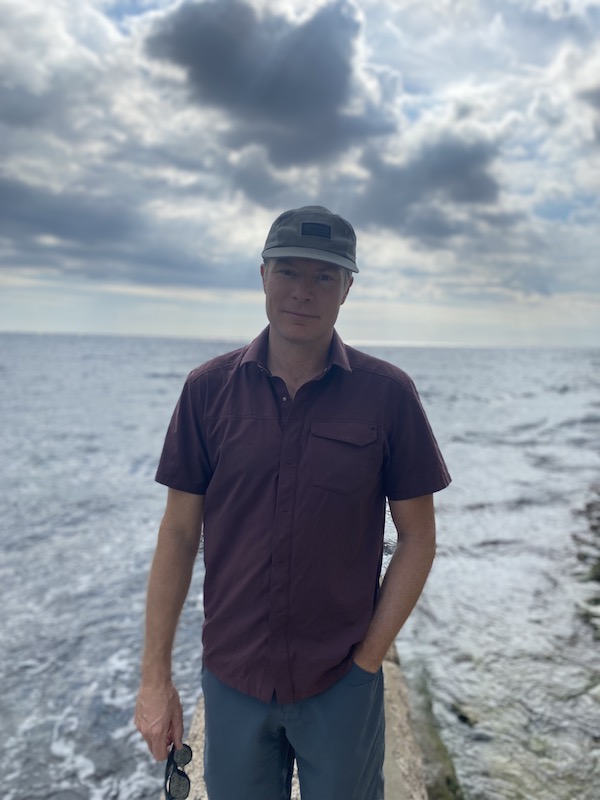
Staying upbeat about progress in his field has been a struggle. He remembers watching his father, the grizzly bear expert, be continually disappointed by how industry and government treated nature. “One of the things that keeps me going is the basic side of my research. Trying to understand bat-insect interactions is all about trying to understand evolution, but even there,” says Barber, “you go to try to catch a moth in Borneo where you caught it before, and there’s a new parking lot instead of the habitat you were working in.”
Recharging in the backwoods helps keep him going. Every year he and his wife go on multi-day rafting trips in some of the Rocky Mountains’ most remote wilderness. They have taken their daughter, Jane, since she was a year old. “She says, ‘Dad, isn’t it so quiet and so dark here!’ It’s really cool for me to see that she understands the real world is dark and quiet.”
George Spencer is a former executive editor of the Dartmouth Alumni Magazine. He lives in Hillsborough, North Carolina.


